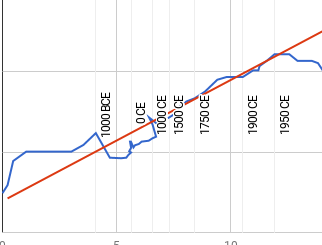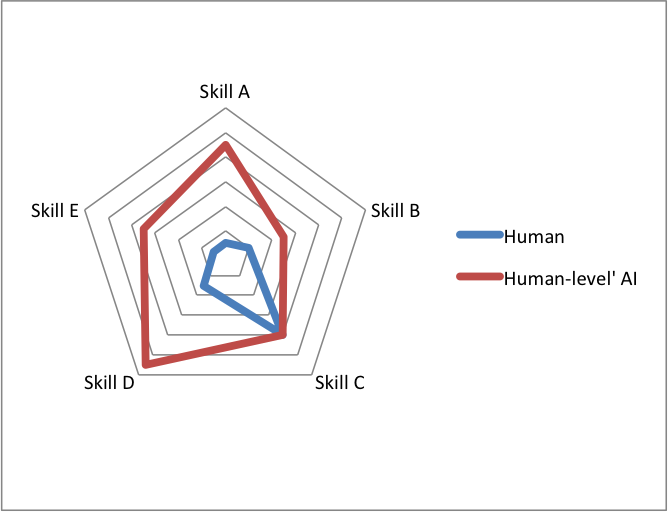The brain has about 10¹¹ neurons and 1.8-3.2 x 10¹⁴ synapses. These probably account for the majority of computationally interesting behavior.
Support
Number of neurons in the brain
The number of neurons in the brain is about 10¹¹. For instance, Azevado et al physically counted them and found 0.6-1 * 10¹¹. Eric Chudler has collected estimates from a range of textbooks, which estimate 1-2 x 10¹⁰ of these (10%-30%) are in the cerebral cortex.1
Number of synapses in the brain
The number of synapses in the brain is known much less precisely, but is probably about 10¹⁴. For instance Human-memory.net reports 10¹⁴-10¹⁵ (100 – 1000 trillion) synapses in the brain, with no citation or explanation. Wikipedia says the brain contains 100 billion neurons, with 7,000 synaptic connections each, for 7 x 10¹⁴ synapses in total, but this seems possibly in error.2
Number of synapses in the neocortex
One way to estimate of the number of synapses in the brain is to extrapolate from the number in the neocortex. According to stereologic studies that we have not investigated, there are around 1.4 x 10¹⁴ synapses in the neocortex.3 This is roughly consistent with Eric Chudler’s summary of textbooks, which gives estimates between 0.6-2.4 x 10¹⁴ for the number of synapses in the cerebral cortex.4
We are not aware of convincing estimates for synaptic density outside of the cerebral cortex, and our impression is that widely reported estimates of 10¹⁴ are derived from the assumption that the neocortex contains the great bulk of synapses in the brain. This seems plausible given the large volume of the neocortex, despite the fact that it contains a minority of the brain’s neurons. By volume, around 80% of the human brain is neocortex.5 The neocortex also consumes around 44% of the brain’s total energy, which may be another reasonable indicator of the fraction of synapses in contains.6 So our guess is that the number of synapses in the entire brain is somewhere between 1.3 and 2.3 times the number in the cerebral cortex. From above, the cerebral cortex contains around 1.4 x 10¹⁴ synapses, so this gives us 1.8-3.2 x 10¹⁴ total synapses.
Number of synapses per neuron
The number of synapses per neuron varies considerably. According to Wikipedia, the majority of neurons are cerebellum granule cells, which have only a handful of synapses, while the statistics above suggest that the average neuron has around 1,000 synapses. Purkinje cells have up to 200,000 synapses.7
Number of glial cells in the brain
Main article: Glial signaling
Azevado et al aforementioned investigation finds about 10¹¹ glial cells (the same as the number of neurons).
Relevance of cells other than neurons to computations in the brain
Main article: Glial signaling
It seems that the timescales of glial dynamics are substantially longer than for neuron dynamics. Sandberg and Bostrom write: “However, the time constants for glial calcium dynamics is generally far slower than the dynamics of action potentials (on the order of seconds or more), suggesting that the time resolution would not have to be as fine” (p. 36). This suggests that the computational role of glial cells is not too great. References to much larger numbers of glial cells appear to be common, but we were unable to track down any empirical research supporting these claims. An informal blog post suggests that a common claim that there are ten times as many glial cells as neurons may be a popular myth.
We are not aware of serious suggestions that cells other than neurons or glia play a computationally significant role in the functioning of the brain.
- Total number of neurons in cerebral cortex = 10 billion (from G.M. Shepherd, The Synaptic Organization of the Brain, 1998, p. 6). However, C. Koch lists the total number of neurons in the cerebral cortex at 20 billion (Biophysics of Computation. Information Processing in Single Neurons, New York: Oxford Univ. Press, 1999, page 87).
- “The human brain has a huge number of synapses. Each of the 1011 (one hundred billion) neurons has on average 7,000 synaptic connections to other neurons. It has been estimated that the brain of a three-year-old child has about 10¹⁵ synapses (1 quadrillion). This number declines with age, stabilizing by adulthood. Estimates vary for an adult, ranging from 10¹⁴ to 5 x 10¹⁴ synapses (100 to 500 trillion).” Wikipedia accessed April 13 ’15, citing “Do we have brain to spare?“. Neurology 64 (12): 2004–5. We have not accessed most of the Drachman paper, but it does at least say “Within the liter and a half of human brain, stereologic studies estimate that there are approximately 20 billion neocortical neurons, with an average of 7,000 synaptic connections each”. This suggests that the Wikipedia page errs in attributing the 7,000 synaptic connections per neuron to the brain at large instead of the neocortex.
- “Within the liter and a half of human brain, stereologic studies estimate that there are approximately 20 billion neocortical neurons, with an average of 7,000 synaptic connections each”.”Do we have brain to spare?“. Neurology 64 (12): 2004–5.
- “Number of synapses in cortex = 0.15 quadrillion (Pakkenberg et al., 1997; 2003)… [the ‘cortex’ probably refers either the cerebral cortex or the neocortex, which is part of and thus should be smaller than the cerebral cortex.]
…Total number of synapses in cerebral cortex = 60 trillion (yes, trillion) (from G.M. Shepherd, The Synaptic Organization of the Brain, 1998, p. 6). However, C. Koch lists the total synapses in the cerebral cortex at 240 trillion (Biophysics of Computation. Information Processing in Single Neurons, New York: Oxford Univ. Press, 1999, page 87).” – Chudler, Brain facts and figures
- Dunbar references anatomical measurements from 1981 and writes “With a neocortical volume of 1006.5 cc and a total brain volume of 1251.8 cc (Stephan et al. 1981), the neocortex ratio for humans is CR = 4.1.” (p. 682).
- “Thus, neocortex accounts for 44% of the brain’s overall consumption.” Lennie, 2003 (p. 495)
- “Number of synapses made on a Purkinje cell = up to 200,000” – Chudler, Brain facts and figures



22 Trackbacks / Pingbacks
Comments are closed.